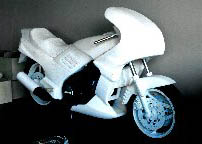THE LEGACY
In spite of the setback due to the banning of six-cylinder machines in endurance racing, the Vee Six project was not a lost cause. Although the 1000/1200 Triple was still one of the fastest motorcycles of the late-70's, Laverda's objective with the Vee Six was to develop a future range of bikes that could be competitive with the Japanese, in terms of performance if not price. There are differing opinions on whether it had ever been intended as a production bike in six-cylinder format, however it certainly was intended to be used as the basis for various engines in smaller configurations - a 350-500cc V-twin, 750-900cc V-four and a 1000-1200cc V6.
Of all the "if only's" that comprise Laverda's later years, a possible 600 triple remains for me the most tantalising - and in hindsight achievable - possibility. My hypothetical machine would have used one head from the Vee Six, the plain bearing crankshaft design, the gear primary drive and suitably upgraded six speed transmission of the existing 500 and a tubular frame along the lines of the earlier 1975 Spaceframe. It would only have required design of a crankcase and suitable balance shaft system and Laverda would have had a characterful 90hp, sub-200kg 600cc sports bike by 1980 - 26 years before Triumph would "invent" the category with their superb 675. If only...
 But this was the late 70's, Laverda's big bikes were never the most profitable at the best of times, and the company were about to receive a number of sequential financial setbacks. The costly problems with the 1979 and 80 triples, the downturn of the bike industry in the early 80's, misguided investments such as the 4x4 & V3 two-stroke, and disagreements within the family company all conspired to prevent any meaningful work on a new generation engine. The only tangible product was the mockup of an inline 4-cylinder machine in 1985, but that too never made it past the conceptual stage.
But this was the late 70's, Laverda's big bikes were never the most profitable at the best of times, and the company were about to receive a number of sequential financial setbacks. The costly problems with the 1979 and 80 triples, the downturn of the bike industry in the early 80's, misguided investments such as the 4x4 & V3 two-stroke, and disagreements within the family company all conspired to prevent any meaningful work on a new generation engine. The only tangible product was the mockup of an inline 4-cylinder machine in 1985, but that too never made it past the conceptual stage.
The great technical adventure had come to an end.

